Since 1975, Disney Parks have been whisking guests into the frigid depths of Space Mountain for close encounters with shooting stars and exploding galaxies. But Disneyland Paris changed everything. There, a one-of-a-kind adventure of discovery was crafted by one of Disney’s most loved Imagineers. And it literally saved Disney’s first European park from declaring bankruptcy.
If you’ve been around Park Lore for a while, you probably know about our library of Lost Legends – in-depth features that tell the behind-the-scenes tales of forgotten favorites that have fallen to the wrecking ball. From Alien Encounter to World of Motion and everything in between, keep your eye out for links to Lost Legends entries across the site..
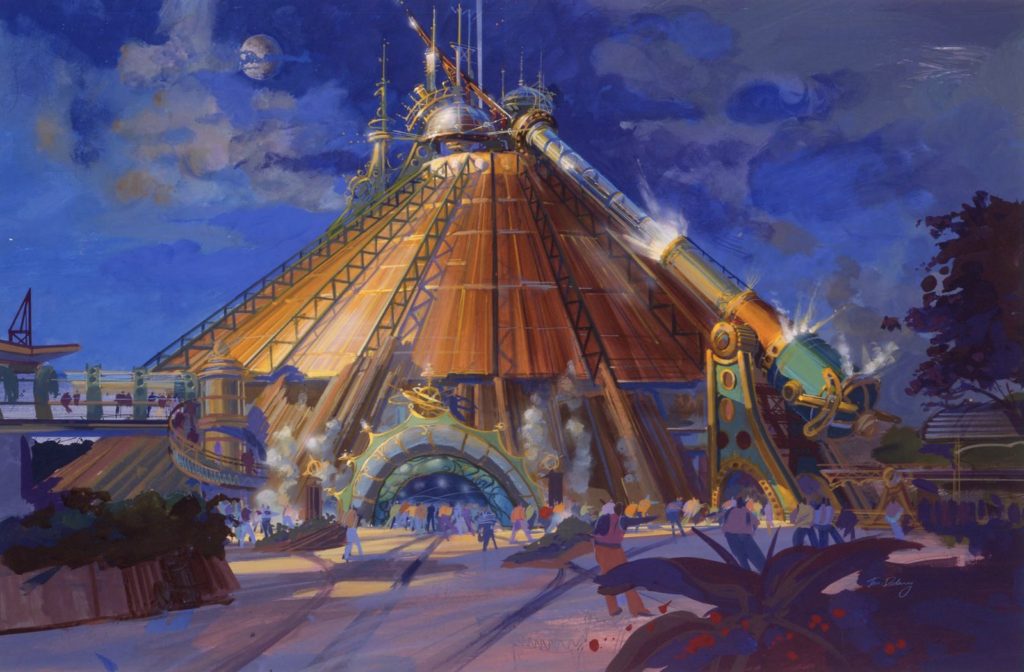
Today, we journey into the vast unknown to explore an unexpected masterpiece at Disneyland Paris. There, the classic Disney attractions you know and love took on entirely new forms, becoming romantic, story-centered adventures based on the collective European imagination. And no lost ride exemplifies that unique shift in thought more than Disneyland Paris’ Space Mountain: De la Terre à la Lune. It was one of the boldest choices Disney’s designers ever made. And then, it was gone.
What lead designers to reimagine the tried-and-true Space Age classic coaster? What inspired the idea of a cannon blasting riders to the moon? Why is this one-of-a-kind coaster destined now to become a carbon copy of a U.S. ride from a totally different land? Today we explore the unbelievable story of the ride that kept Disneyland Paris from closing.
And before we head off, remember that you can unlock rare concept art and audio streams in this story, access over 100 Extra Features, and recieve an annual Membership card and postcard art set in the mail by supporting this clickbait-free, in-depth, ad-free theme park storytelling site for as little as $2 / month! Become a Park Lore Member to join the story! Until then, let’s start at the beginning…
Ready to launch? Cinq, quatre, trois, deux, un…
From the snow to the stars
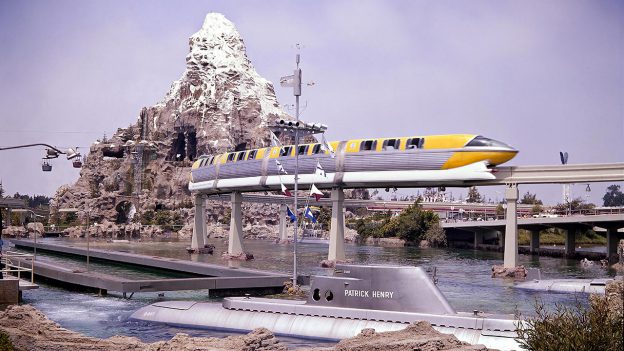
The path to Disneyland Paris’ one-of-a-kind Space Mountain begins not in the stars, but in the snow. After all, when the Matterhorn Bobsleds made its debut at Disneyland on June 14, 1959, it wasn’t just one of three E-Tickets that all launched on the same day (alongside the Monorail and the Submarine Voyage); it was the world’s first modern steel roller coaster.
Just imagine: before the Matterhorn Bobsleds, all modern coasters were what we’d now call wooden coasters! Developed by Arrow Dynamics, the Matterhorn instead used tubular steel rails, able to be heated and bent to any angle. Steel tracks also provided smoother rides than wooden coasters. And that’s not all. Walt’s Matterhorn also debuted a new and extraordinary cutting edge ride control block braking system, allowing more than one vehicle to safely navigate the ride’s course at a time!
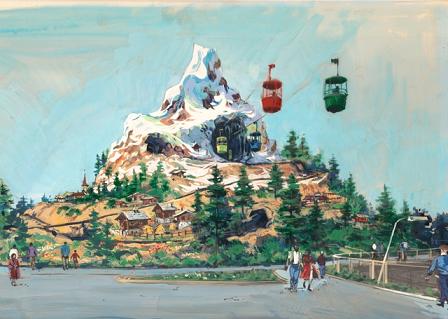
In fact, in our Extras look at the Peaks of Imagineering, we cited Matterhorn as the ride that started it all. Disneyland’s first authentic thrill ride, it’s safe to say that none of Disney Parks’ other mountains would be the same without the Matterhorn. But above all else, the Matterhorn’s greatest contribution might be that it convinced a wary Walt that thrill rides – even roller coasters! – could fit into his dreamy fantasy park.
In fact, five years later in 1964, Walt approached Imagineer and Disney Legend John Hench and tasked him with designing a new thrill ride that could serve as the focal point for an upcoming “New Tomorrowland” he’d be dreaming of.
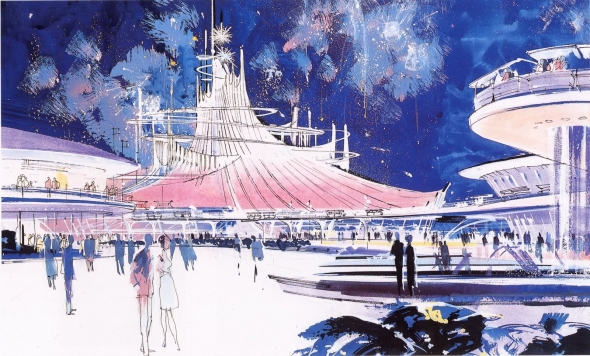
A leap forward for the steel coaster concept, Walt and John developed the concept of an indoor roller coaster expanding upon the lessons learned from Matterhorn. The ride quickly gained the name Space Port. Plans continued to move forward for this “New Tomorrowland,” and the indoor, outer-space themed ride would’ve been more than just the headlining E-Ticket… its graceful curves, Space Age styles, and sleek white spires would set the visual style for the entire land-wide renovation.
Before any ground would be broken on Disneyland’s Space Port, though, development in the mid-1960s shifted to the new “Disney World” to be built in Florida. Then, Walt’s unexpected death in 1966 seemed to sideline any hope of Disneyland getting a Space Port coaster at all. But even if Walt’s death had changed everything at Disney Parks, a new generation of designers now arrived in WED Enterprises with a lot to learn and as many ideas to share…
Tony Baxter
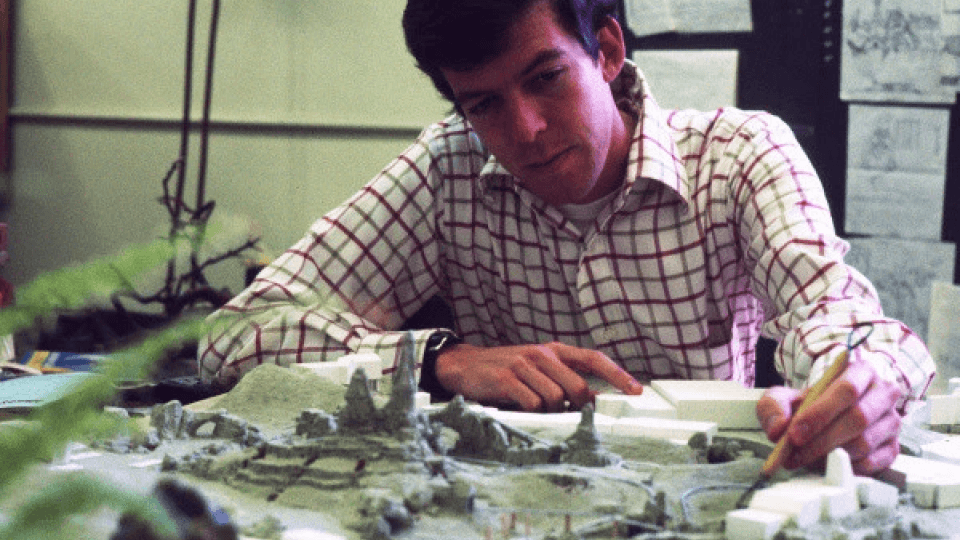
Disney Legend Tony Baxter is often held up as a pivotal figure in many of our Lost Legend stories, and for good reason. For one, he’s often cited as one of the first in a “next generation” of Imagineers, brought into WED Enterprises just as work ramped up on the new Disney World. Consequently, Baxter and the rest of that fresh “class” were among the first Disney designers to have never worked alongside Walt himself (even if they’d learn from Imagineering masters like Marc Davis and Claude Coats)!
But Baxter and his peers brought a unique strength, too… Unlike those long-standing masters who’d seen Disneyland first as sketches, then models, then steel, Baxter’s first experience with Disneyland was as a child; the kind of authentic, guest-perspective of growing up in the park that Walt and his original designers simply couldn’t have.
In fact, Baxter famously began his career with Disney as an ice cream scoop on Main Street, then a ride operator on the park’s Submarine Voyage. It was only when his college portfolio project was referred to Imagineering that Baxter was encouraged to change his major at Cal State Long Beach, graduating in 1969 and joining WED just as the rush to Walt Disney World’s creation reached its height.
Imagine being fresh out of school and being assigned to work with legendary Imagineer Claude Coats to refract a Disneyland classic to Magic Kingdom… Yep, months after operating Disneyland’s Submarine ride, Baxter was tasked with helping to design Disney World’s version (see the Passholder-exclusive rare construction photo, above!).
To do so, he worked with Coats to reimagine Anaheim’s Tomorrowland-set scientific styling in favor of a Fantasyland-friendly, Jules Verne’s 19th century adventure novel. The result was, of course, the Lost Legend: 20,000 Leagues Under the Sea: Submarine Voyage, a beloved closed classics still celebrated today.
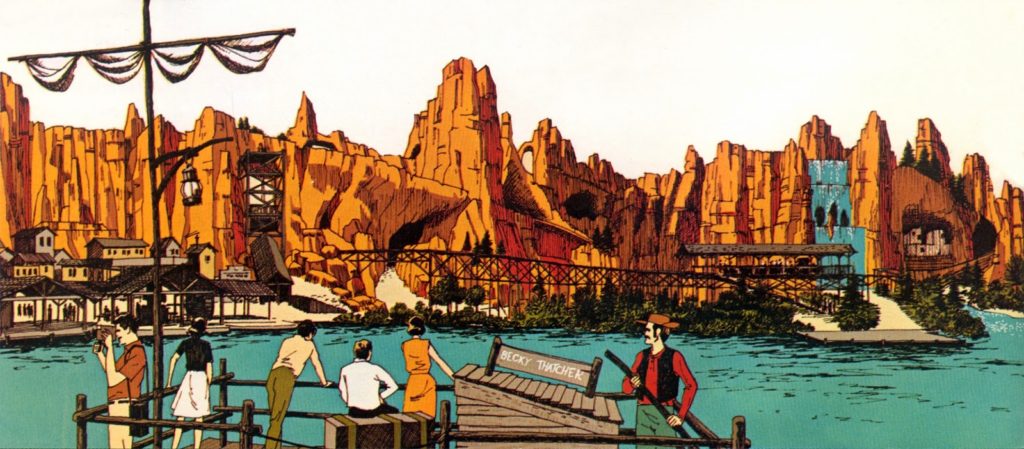
Meanwhile, Baxter was paired with Imagineer and animator Marc Davis on the elaborate and ambitious Possibilityland: Western River Expedition imagined for Magic Kingdom’s Frontierland. While Marc himself was happy to handle the epic, Audio-Animatronic heavy dark ride that would serve as the park’s equivalent of Pirates of the Caribbean, he tasked Baxter with developing one of the side attractions: an outdoor roller coaster that would ride across the mesas and rock formations of the ride’s desert mountain showbuilding.
In any case, Baxter’s trial-by-fire of working alongside Coats and Davis was just the start… And having dipped his toes into the waters of both roller coasters and Jules Verne’s science-fantasy literature, the ingredients were gathering toward one of Disney’s most spectacular adventure rides ever…
The Age of the Coaster
In the 1970s – after Walt’s death and the completion of Magic Kingdom – things began to change at Walt Disney Productions and the Disney theme parks. Without Walt’s direction, projects began to slow to a crawl; decisions weren’t getting made, and neither were hit films. The “Disney Dark Ages” had arrived, and the era of high-cost, Audio-Animatronic-heavy attractions was over. Rides like Pirates, Haunted Mansion, and – yep – the Western River Expedition were a thing of the past.
The alternative?
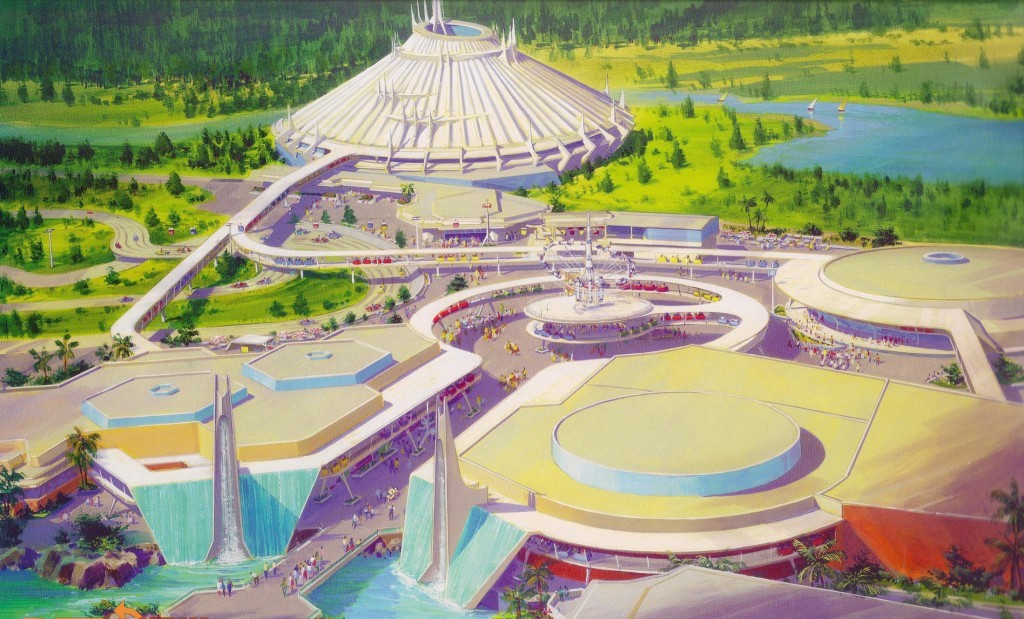
Given that Magic Kingdom’s first years have proved unexpectedly popular for pre-teens and young adults, Imagineers got to reconsidering the forgotten plans for a roller coaster through space as an added thrill. Altogether, roller coasters were much less expensive than the dark rides of the ’60s. Plus, the Tomorrowland in Florida offered the right amount of space, and technology had advanced sufficiently to imagine that this complex coaster could actually exist in a refined, conical peak just outside of the park’s railroad tracks.
Space Mountain opened first in Disney World’s Magic Kingdom, on January 15, 1975. The dual mirror-imaged roller coaster tracks inside were actually inspired by the two tracks on Disneyland’s Matterhorn Bobsleds… including the use of tandem bobsled-style trains! Providing generations of guests with the unimaginable sensation of soaring through the stars, Space Mountain wasn’t just a hit – it was a visual icon for Walt Disney World, and a landmark of the Space Age.
So when the attraction proved wildly popular at Disney World, the opportunity to bring the concept back West was too good to pass up. Since Magic Kingdom’s Space Mountain had been based closely on Disneyland’s own dual-tracked Matterhorn, designers would need to concoct a new layout for the Californian version of the ride – a single-tracked modern coaster with more standard side-by-side seating, which opened at Disneyland in 1977.
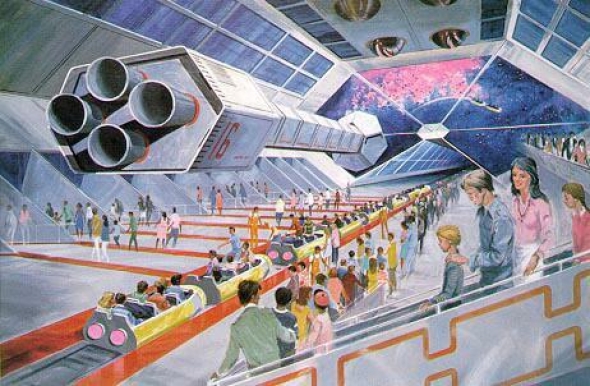
The two roller coasters in Florida and California might’ve each been unique, but they had something in common: they were sensational, iconic landmarks of mid-century Americana, giving guests the chance to zip through outer space in a memory-making journey unlike any other available on Earth or beyond. That’s why you’ll find an in-depth exploration of the ride’s history and experience in its own Modern Marvels: Space Mountain feature – some good pre-reading for the story today!
And while designers were bringing Space Mountain to life, young Tony Baxter was working on salvaging at least part of the Western River Expedition – the roller coaster through the desert he’d be working on seemed a perfect fit for Disney’s new direction. With roller coasters, space, and Jules Verne swirling, the plans began to form… Read on…




